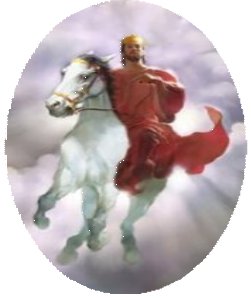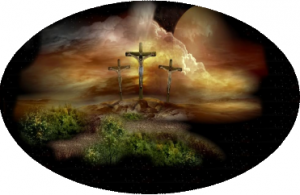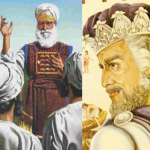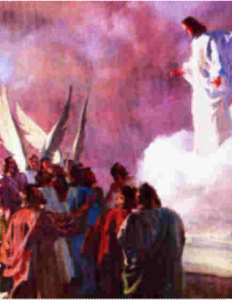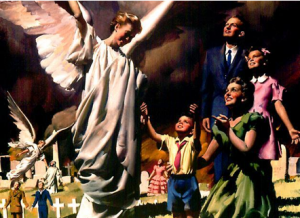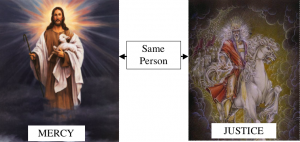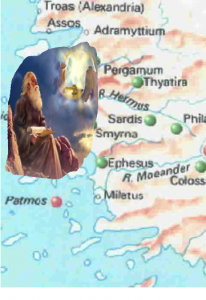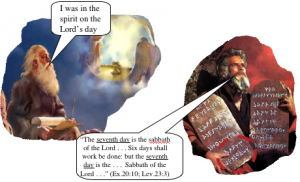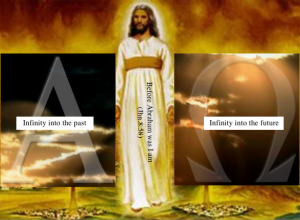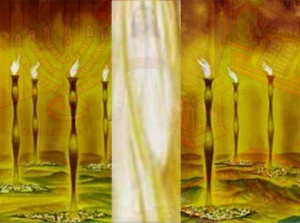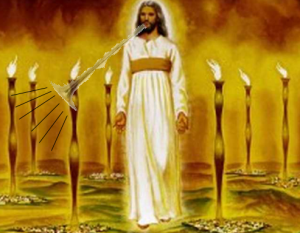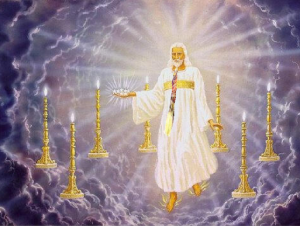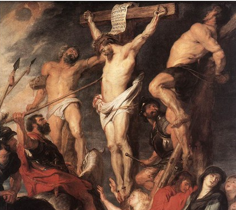The importance of the Book of Revelation cannot be overemphasized. “We have been given a message exceeding in importance any other message ever entrusted to mortals. This message Christ came in person to the Isle of Patmos to present to John. He told him to write down what he saw and heard during his vision, that the churches might know what was to come upon the earth.” [1]
“Many have entertained the idea that the book of Revelation is a sealed book, and they will not devote time and study to its mysteries. They say that they are to keep looking to the glories of salvation, and that the mysteries revealed to John on the Isle of Patmos are worthy of less consideration than these.
“But God does not so regard this book. He declares: ‘I testify unto every man that heareth the words of the prophecy of this book, If any man shall add unto these things, God shall add unto him the plagues that are written in this book: and if any man shall take away from the words of the book of this prophecy, God shall take away his part out of the book of life, and out of the holy city, and from the things which are written in this book. He which testifieth these things saith, Surely I come quickly’ . . . It should be studied with reverential awe.” [2]
“In the Revelation all the books of the Bible meet and end. Here is the complement of the book of Daniel.” [3] Thus we can expect that this book “rounds out” all the other books in the Bible, and even more specifically, the parallels in the book of Revelation complete or perfect the prophecies found in the book of Daniel. It is incumbent upon us, as we embark on this most important study, to be on the alert to find those parallels that are complementary to Daniel’s awesome prophecies. That should not be surprising. After all, the same Person who ministered to Daniel, also inspired John.
Note: John “wrote down what he saw and heard during his vision,” not what he thought, believed or understood. Daniel, who “heard, but . . . understood not” (Daniel 12:8), did the same thing. Furthermore, “the book that was sealed is not the Revelation, but that portion of the prophecy of Daniel relating to the last days.” [4] [5]
“None should become discouraged in the study of the Revelation because of its apparently mystical symbols.” [6] “In the revelation given to him [John] there was unfolded scene after scene of thrilling interest in the experience of the people of God, and the history of the church was foretold to the very close of time.” [7] In fact “. . . subjects of vast importance were presented to John, which he was to record, that the people of God, living in his age and in future ages might have an intelligent understanding of the perils and conflicts before them.” [8] “Revelation is . . . an opened book. It records marvelous events that are to take place in the last days of this earth’s history. The teachings of this book are definite, not mystical and unintelligible.” [9] Therefore, we can assume that it is understandable, in spite of the fact so many seem to believe it is incomprehensible.
Verse 1: The Revelation of Jesus Christ, which God gave unto him, to shew unto his servants things which must shortly come to pass; and he sent and signified it by his angel unto his servant John:
This “Revelation” came 634 years [10] after “Jesus Christ,” named “Michael (Daniel 12:1) . . . the man clothed in linen” (Daniel 10:5; 12:6, 7), delivered the last message that came to Daniel. That last message, with Michael standing up in the context of the judgment that began in 1844 (see Daniel 7:26; 8:14; 12:1), concerned the role of Jesus in the heavenly sanctuary setting. Now, in the first chapter of the book of Revelation, we again see Jesus showing His servant John some very special Revelations concerning “things which must shortly come to pass.” We will also find that much of it is depicted in the context of His position in the heavenly sanctuary where He is represented as the Lamb, the most important feature of the sanctuary message. As a matter of fact, the “Lamb” is depicted twenty seven times in the book of Revelation, but only four other times in the New Testament! That fact alone should alert us to how important it is to understand the sanctuary message in order to understand what the book of Revelation is all about.
By this time, Jesus Christ, called “Messiah the Prince” (Daniel 9:25), had been “cut off” “in the midst of the [final] week” of the “seventy” (Daniel 9:27). That happened 65 years before His appearance to John [11] the very last of the twelve disciples of Jesus. The others, by that time, had all been martyred.
Now, Jesus, who received His Revelation from God the Father, came to reveal “things” that would soon “come to pass.” As the word “things” implies: “The teachings of this book are definite, not mystical and unintelligible.” [12] And they were to be made known [13] by “his angel,” which must be Gabriel, whom the Lord had instructed: “make this man [Daniel] to understand the vision [mar’eh]” (Daniel 8:16), as well as more information about the “things [that] shall be finished” (Daniel 12:7).
Daniel finally understood the 2300 day “mar’eh” (see Daniel 10:1). But details of the “chazown,” that Gabriel and Michael purposed to “make [him] understand what shall befall thy people in the latter days: for yet the vision [chazown] is for many days” (Daniel 10:14), escaped him. Finally, in frustration, he exclaimed: “I heard, but I understood not” (Daniel 12:8). But Daniel’s reaction should not have surprised Gabriel, because he had already told Daniel to “shut thou up the vision [chazown]; for it shall be for many [or ‘more’] days” beyond the 2300-day “mar’eh” (Daniel 8:26). Later, still, he repeated: “shut up the words, and seal the book, even to the time of the end” (Daniel 12:4), which is the “chazown” that extends over and beyond the “mar’eh” to the very end of time (see Daniel 8:17)!
Consequently, since the “book of Daniel is unsealed in the revelation to John,” [14] it is the end time portion of the “chazown,” that is “for . . . the time of the end” (Daniel 8:17), that is now unsealed in the Revelation opened to John.
“Why, then, this wide-spread ignorance concerning an important part of Holy Writ? Why this general reluctance to investigate its teachings? It is the result of a studied effort of the prince of darkness to conceal from men that which reveals his deceptions.” [15] As our exploration of prophecy continues, we will discover that the “Revelation” really does reveal Satan’s deceptions more clearly than any other book of the Bible!
Verse 2: Who bare record of the word of God, and of the testimony of Jesus Christ, and of all things that he saw.
This is an important verse. John’s “record” is not what he sat down and figured out based on his own experience or what he knew, it is what “he saw,” and, we might add, what he “heard,” as noted in Verse 10. “The Revelation is a factual, eye- and ear- witness report of what John saw and heard while in vision.” [16] The parallels we find in other parts of the Old Testament, including the book of Daniel, should not be considered evidence of John’s deliberate attempt to include them, but evidence of the Holy Spirit’s influence who inspired all the writers of the Old Testament as well as the New. Therefore, parallels between the book of Revelation and many things in the Old Testament are to be expected.
“Subjects of vast importance were revealed to him, especially for the last church, that those who should turn from error to truth might be instructed concerning the perils and conflicts before them. None need be in darkness in regard to what is coming upon the earth.” [17]
God, in His great mercy and tender regard for His people, recognizes that unexpected trials and delays are much more difficult to bear than expected ones. “Surely the Lord GOD will do nothing, but he revealeth his secret unto his servants the prophets” (Amos 3:7). “For I know the thoughts that I think toward you, saith the LORD, thoughts of peace, and not of evil, to give you an expected end” (Jeremiah. 29:11).
Since this “record” is “the testimony of Jesus Christ,” all who love Jesus should give it their most loving and devoted attention. In fact, “the solemn messages that have been given in their order in the Revelation are to occupy the first place in the minds of God’s people. Nothing else is to be allowed to engross our attention.” [17a]
Verse 3: Blessed is he that readeth, and they that hear the words of this prophecy, and keep those things which are written therein: for the time is at hand.
Note the similarity the promise to Daniel: “Blessed is he that waiteth, and cometh to the thousand three hundred and five and thirty days” (Daniel 12:12), implying the book of Revelation is especially designed to comfort and encourage “he that waiteth.”
While “blessed” means “how happy” (Daniel 12:12), the Greek word for “blessed,” “makarios,” [18] also means “happy,” even “happier.” In contrast to Daniel’s reference to it only once [19] as a happy, anticipatory state of mind, John makes reference to it seven times (see Revelation 1:3, 14:13, 16:15, 19:9, 20:6, 22:7, 14), all of which depict happiness, or confidence in anticipation of some wonderful event.
“Says the prophet: ‘Blessed is he that readeth’ ―there are those who will not read; the blessing is not for them. ‘And they that hear’ ―there are some, also, who refuse to hear anything concerning the prophecies; the blessing is not for this class. ‘And keep those things which are written therein’ ―many refuse to heed the warnings and instructions contained in the Revelation; none of these can claim the blessing promised. All who ridicule the subjects of the prophecy, and mock at the symbols here solemnly given, all who refuse to reform their lives, and prepare for the coming of the Son of man, will be unblest.
“In view of the testimony of Inspiration, how dare men teach that the Revelation is a mystery, beyond the reach of human understanding? It is a mystery revealed, a book opened. The study of the Revelation directs the mind to the prophecies of Daniel, and both present most important instruction, given of God to men, concerning events to take place at the close of this world’s history.” [20]
It’s like the light at the end of a very long, dark tunnel that inspires confidence and hope.
“To John were opened scenes of deep and thrilling interest in the experience of the church. He saw the position, dangers, conflicts, and final deliverance of the people of God. He records the closing messages which are to ripen the harvest of the earth, either as sheaves for the heavenly garner or as fagots for the fires of destruction . . . Christ the Revelator, foreseeing the warfare that would be waged against the study of the Revelation, pronounced a blessing upon all who should read, hear, and observe the words of the prophecy.” [21]
Verse 4: John to the seven churches which are in Asia: Grace be unto you, and peace, from him which is, and which was, and which is to come; and from the seven Spirits which are before his throne;
Verse 11 names “the seven [Christian] churches” which actually existed contemporaneously “in Asia” (or Asia Minor, better known as Turkey), back in John’s time around 96 A.D. when he received this vision. But it would be unwise to conclude the specific messages, assigned to each church in the following two chapters, applied only to those ancient churches and have no present-day relevance to the churches of our day.
Interestingly, the word “grace,” used in this salutation, is referred to only one other time (Revelation 22:21), and “peace,” one other time where it is taken away “from the earth” by the rider of a “horse that was red” (Revelation 6:4).
But, the giver of both “grace and peace” comes “from him which is, and which was, and which is to come,” who is God the Father. It does not come from “the beast that was, and is not, and yet is” (Revelation 17:8). [22] Does that mean the “beast” is the rider of the red horse? We will find out later.
Verse 5: And from Jesus Christ, who is the faithful witness, and the first begotten of the dead, and the prince of the kings of the earth. Unto him that loved us, and washed us from our sins in his own blood,
Jesus Christ is “the faithful and true witness” to the very last church, “the church of the Laodiceans” (Revelation 3:14). He is “the prince of the kings of the earth, and “the prince of princes” (Daniel 8:25), “Messiah the Prince” (Daniel 9:25), “Michael, one of the chief princes” (Daniel 10:13) that Gabriel told Daniel was “Michael your prince” (Daniel 10:21), “the prince of the covenant” (Daniel 11:22), and “Michael . . . the great prince which standeth for the children of thy people” (Daniel 12:1).
He is the rider of “a white horse” whose name “was called Faithful and True, and in righteousness he doth judge and make war” (Revelation 19:11) and sits astride the same “white horse” as “he went forth conquering, and to conquer” (Revelation 6:2) in the “war” between Himself and Satan.
He is “the first begotten of the dead” or, as Paul says, “the firstfruits of them that slept” (1 Corinthians 15:20), while the 144,000 are “the first fruits unto God and to the Lamb” (Revelation 14:1, 4) from among the living because they followed “the Lamb whithersoever he goeth” during the final hours of the “chazown.” [23]
In spite of His supremely exalted position, He stooped low and “washed us from our sins in his own blood.” Wonder of wonders! What magnificent, awesome, selfless love!
Verse 6: And hath made us kings and priests unto God and his Father; to him be glory and dominion for ever and ever. Amen.
The Commentary suggests a different reading of the first clause as: “’a kingdom, priests’ . . . Christ has constituted His church a ‘kingdom’ and its individual members ‘priests.’ To be a member of the kingdom is to be a ‘priest.’” [24] The same phrase is found in Revelation 5:10 where “the four beasts and four and twenty elders, fell down before the Lamb” (see Revelation 5:8-10) singing He “hast made us unto our God kings and priests: and we shall reign on the earth” which “in chs. 20; 21 is shown to be in the postmillennial period.” [25] Therefore, we, as believers, are “priests” in His kingdom right now, but “kings” later on when “the meek . . . shall inherit the earth” (Matthew 5:5), the wonderful event depicted in Revelation 21.
Verse 7: Behold, he cometh with clouds; and every eye shall see him, and they also which pierced him: and all kindreds of the earth shall wail because of him. Even so, Amen.
John was one of the “men of Galilee” who stood “gazing up into heaven” while Jesus “was taken up; and a cloud received him out of their sight” 38 years before. [26] Then two angels announced: “this same Jesus . . . shall so come in like manner as ye have seen him go into heaven” (Acts 1:9, 11). While that experience must have flashed through John’s mind, he may or may not have thought of the same thing Gabriel told Daniel centuries before about the time when “Michael [shall] stand up, the great prince which standeth for the children of thy people . . . And many of them that sleep in the dust of the earth shall awake, some to everlasting life, and some to shame and everlasting contempt” (Daniel 12:1).
In both passages there is a resurrection of both the righteous and the wicked at the time of the second coming. Note that while Daniel depicted the resurrection of the wicked in a general manner as those who will arise “to shame and everlasting contempt,” John is more specific, saying, only those who actually “pierced him” will be raised at that time. John actually witnessed this happen when the soldiers brutally nailed his beloved Master to the cross and saw “one of the soldiers with a spear [that] pierced his side” (John 19:34). Therefore, John’s message here is parallel, and complementary to Daniel’s, giving us a more complete picture of some of the things Gabriel tells us (Daniel 12:1, 2).
White, after quoting “many of them that sleep in the dust of the earth . . . awake, some to everlasting life, and some to shame and everlasting contempt (Dan. 12:2),” says: “All who have died in the faith of the third angel’s message come forth from the tomb glorified to hear God’s covenant of peace with those who have kept His law.” Then after quoting “’they also which pierced him’ (Rev. 1:7),” says: “. . . those that mocked and derided Christ’s dying agonies, and the most violent opposers of His truth and His people, are raised to behold Him in His glory, and to see the honor placed upon the loyal and obedient.” [27]
Therefore, Revelation 1:7 and Daniel 12:2 depict a “special” resurrection which will likely take place at the end of the “thousand three hundred and five and thirty days” (Daniel 12:12). Those who endure will be “blessed” exceedingly when they are reunited with loved ones who died “by the sword, and by flame” sometime after the “vile person,” together “with them that [forsook] the holy covenant . . . place[d] the abomination that maketh desolate” (Daniel 11:30-33).
This brings up an interesting comparison. While all of Daniel’s visions, with Chapter 2 ending with the stone that strikes the image on its feet, Chapter 7 ending with “all dominions” serving and obeying Christ, Chapter 8 ending with the “chazown” lasting more “days” beyond the “mar’eh,” Chapter 9 concluding with the “consummation” at the “end of the war,” and Chapter 12 finishing at “the end of the days,” Revelation begins with one the most vivid presentations of the second coming found in either Revelation or Daniel. While many events in John’s vision end near the time of the second coming or describe situations immediately after the second coming, Revelation 1:7 and 6:14-17 are the sole examples of the actual second coming of Christ.
Verse 8: I am Alpha and Omega, the beginning and the ending, saith the Lord, which is, and which was, and which is to come, the Almighty.
This verse is mind bending because it is difficult to conceptualize a Person who, possessing such awesome power and mastery, could yet be so loving and condescending. But this is Jesus, the same “man clothed in linen” (Daniel 10:5; 12:6, 7) who spoke to Daniel six hundred years before. He claims the same attributes as God the Father, whom John, using identical words, identified “him which is, and which was, and which is to come” (Verse 4). [28]
Therefore, like God the Father, “Jesus Christ” is also the self-existent One, just as He declared to the Jews a few years before when He told them, “Before Abraham was, I am.” For that, the Jews “took . . . up stones to cast at him:” (John 8:58, 59). Later, Paul noted, He “thought it not robbery to be equal with God” (Philippians 2:6). Now, Jesus adds, “I am . . . the Almighty” [29] making Him second Person of the Godhead, the ultimate Source of all that is written in the book of Revelation!
Verse 9: I John, who also am your brother, and companion in tribulation, and in the kingdom and patience of Jesus Christ, was in the isle that is called Patmos, for the word of God, and for the testimony of Jesus Christ.
The “seven churches which are in Asia” were also suffering “tribulation” that John himself was experiencing being exiled to “the isle . . . called Patmos” out in the Aegean Sea.
John “The last survivor of the disciples who had been intimately connected with the Saviour. . . had great influence in setting forth the fact that Jesus was the Messiah, the Redeemer of the world. No one could doubt his sincerity, and through his teachings many were led to turn from unbelief.
“The rulers of the Jews were filled with bitter hatred against John . . . [and] declared that their efforts against the Christians would avail nothing so long as John’s testimony kept ringing in the ears of the people . . . John was accordingly summoned to Rome to be tried for his faith . . . False witnesses accused him of teaching seditious heresies. By these accusations his enemies hoped to bring about the disciple’s death.
“John answered for himself in a clear and convincing manner . . . But the more convincing his testimony, the deeper was the hatred of his opposers. The emperor Domitian was filled with rage. He could neither dispute the reasoning of Christ’s faithful advocate, nor match the power that attended his utterance of truth; yet he determined that he would silence his voice.
“John was cast into a cauldron of boiling oil; but the Lord preserved the life of His faithful servant, even as He preserved the three Hebrews in the fiery furnace . . . and John was removed from the caldron by the very men who had cast him in.” [30]
Note how John equates “the kingdom” with the “patience of Jesus Christ,” implying that delay would be an important factor in the “tribulation” the church would be forced to experience, and the need for “patience” is an imperative in order to endure. This coincides with the Saviour’s warning several years before when He referred to “that evil servant [that] shall say in his heart, My lord delayeth his coming” (Matthew 24:48), a complaint heard all too frequently, even in our day, more than 2,000 years later!
Verse 10: I was in the Spirit on the Lord’s day, and heard behind me a great voice, as of a trumpet,
The Commentary suggests being “in the Spirit” as “an ecstatic state” when John “became oblivious to the things of earth and aware only of the impressions conveyed to him by the Holy Spirit.” [31]
John notes being “in the spirit” three other times (Revelation 4:2; 17:3; 21:10), suggesting he was “in the spirit” at other times. For example, in Verses 1-9, of this chapter, he describes what he saw and heard. But, in Verses 7 and 8, when John comments “every eye shall see him,” and then quotes Jesus saying “I am Alpha and Omega,” it would seem he was “in the spirit” at that time. Therefore, it becomes difficult to distinguish when he was actually “in” or “out” of “the Spirit” and we should question the idea that Verses 1-9 were only his own ideas because he did not say if he was “in the spirit” at that time. Therefore, it is safe to say what he saw and heard, whether in or out of the spirit, was inspired. It was not his own ideas or conjectures.
While the book of Revelation is “the complement of the book of Daniel,” there are distinct differences. The visions that came to Daniel occurred “in the second year of the reign of Nebuchadnezzar,” “In the first year of Belshazzar” “In the third year of . . . Belshazzar,” “In the first year of Darius,” and finally “In the third year of Cyrus” (Daniel 2:1; 7:1; 8:1; 9:1; 10:1). John’s vision came to him “on the Lord’s day.” Evidently, it all came on that one, Sabbath “day” [32] since John gives no hint that other days were occupied while experiencing other visions. Consequently, it seems, while the book of Daniel depicts several, explicit visions, the book of Revelation is really only one vision that came to John on “the Lord’s day,” the seventh day Sabbath, even though it is conceivable, perhaps likely, it took him many other days to write it all down.
Nevertheless, the book of Revelation should be considered as a whole and not a series of disconnected thoughts and ideas. Everything in this book is interrelated. Each passage bears relationship to the others which makes context an extremely important consideration before coming to a conclusion. Consequently, the chapter designations are not part of the inspiration. It was written out uninterruptedly and we should resist the tendency to isolate the chapters from each other and ignore their contexts.
At this point, John relates that while he was “in the Spirit” he heard “a great voice, as of a trumpet.” Interestingly, the trumpet-like quality of Jesus’ “voice” identifies the “first voice” John heard (Revelation 4:1) as that of Jesus Himself. His angelic emissaries also sound like a “trumpet” or “trumpets” (Revelation 8:2, 6, 13; 9:14. In contrast, there are no “trumpets” depicted in the book of Daniel. Therefore, the “trumpet” bears special significance in the book of Revelation.
Verse 11: Saying, I am Alpha and Omega, the first and the last: and, What thou seest, write in a book, and send it unto the seven churches which are in Asia; unto Ephesus, and unto Smyrna, and unto Pergamos, and unto Thyatira, and unto Sardis, and unto Philadelphia, and unto Laodicea.
Jesus had already said “I am Alpha and Omega” (Verse 8), making it clear He is equal with God the Father. He repeats it twice more in the last two chapters of Revelation, suggesting that He ratifies everything contained between Chapters 1 and 22, making Him to be the real Author of the book of Revelation and, most importantly, “the center of all hope” [33] for he is the “Alpha and Omega, the first and the last” of all the subjects in both Daniel and the Revelation. Furthermore, there was never a time in the past, neither will there be a time in the future, when He did not nor will not exist.
John, we might say, was just His secretary who faithfully wrote down in his own words what he saw and heard, rather than what he thought. Therefore, the book of Revelation is not an imaginary allegory that John had thought up on his own for the benefit of the “seven churches which [were] in Asia” during his time.
In fact, “The names of the seven churches are symbolic of the church in different periods of the Christian Era. The number 7 indicates completeness, and is symbolic of the fact that the messages extend to the end of time, while the symbols used reveal the condition of the church at different periods in the history of the world.” [34]
Verse 12: And I turned to see the voice that spake with me. And being turned, I saw seven golden candlesticks;
The approach of One “like unto the Son of man” was from behind the prophet. Perhaps John was facing the sea at the time of this encounter, reflecting on the various spiritual problems of the Asian churches. Without doubt he was praying for the added wisdom Jesus was just about to provide in super abundance!
But, after he had “turned,” the first thing catching his attention was the “seven golden candlesticks.”
A quarter of a century before, in 70 A.D., the temple at Jerusalem had been completely destroyed by the Romans. John actually “witnessed the destruction of Jerusalem and the ruin of the stately temple.” [35] Even though the Jewish nation had, out of hand, rejected Jesus Christ as the Messiah, the significance of the seven candlesticks must have been very meaningful to John. Most certainly he was among the disciples when they “were come together . . . while they beheld, [Jesus being] taken up; and a cloud received him out of their sight” (Acts 1: 6, 9). Therefore, John was eyewitness to the fact that Jesus was in heaven. He also knew “seven golden candlesticks” were represented by the “seven lamps,” in the first apartment of the earthly sanctuary (Exodus 25: 37; 37:23). The significance of that symbology, that represented Jesus’ office space in the first apartment of the heavenly sanctuary, must have been clear to John (even though Jesus assigned additional meaning to the candlesticks in the last verse of this chapter).
Verse 13: And in the midst of the seven candlesticks one like unto the Son of man, clothed with a garment down to the foot, and girt about the paps with a golden girdle.
A rather unusual place to be standing, but there is good reason for Christ to present Himself thus. In Verse 20 Jesus says, “the seven candlesticks . . . are the seven churches.” Therefore, “This Scripture shows Christ’s relation to the churches. He walks in the midst of His churches throughout the length and breadth of the earth. He watches them with intense interest to see whether they are in such a condition spiritually that they can advance His kingdom.” [36]
I know the trumpet in this picture is a little bit weird, but remember, Verse 10 says He had “a great voice, as of a trumpet,” an important item we will need to remember in Chapter 4. But note in Verse 16 “a sharp twoedged sword went “out of his mouth.”
So, being “in the midst of” His churches suggests He is judging them, not with suspicious paranoia, but with loving concern. His clothing, with “a garment down to the foot,” is similar to the “holy garments” worn by the priests in the typical service of the earthly sanctuary (Exodus 28:2, 4; 20:29; 31:10; 35:19, 21; 39:1; 40:13; Leviticus 16:4, 32). While the hem of those garments must have reached “down to” their feet, Christ’s is the only one so described. And while the priests in the earthly sanctuary all used girdles, Christ’s is the only one that was “golden.” Very likely, His “garment” must be made of “linen” that “a certain man” was “clothed” with (Daniel 10:5; 12:7).
Note the nearly identical title of “one like unto the Son of man” with “one like the Son of man” (Daniel 7:13) who “came to the Ancient of days” at a special moment in heaven’s history. We will find that very same moment depicted in Revelation 5.
Verse 14: His head and his hairs were white like wool, as white as snow; and his eyes were as a flame of fire;
The “Ancient of days,” God the Father, also had “hair . . . like the pure wool” (Daniel 7:9) and the “eyes” of “a certain man clothed in linen,” God the Son, were “as lamps of fire” (Daniel 10:5,6).
Verse 15: And his feet like unto fine brass, as if they burned in a furnace; and his voice as the sound of many waters.
Although all illustrations leave out something, this picture probably accords better with John’s description of what Jesus looked like.
According to Daniel, the “arms and . . . feet” belonging to “a certain man clothed in linen,” were “like in colour to polished brass” and “the voice of his words like the voice of a multitude” (Daniel 10:5,6).
Those parallels strongly suggest Jesus is about to give John an expanded, complementary version of what He had told Daniel in the sealed [37] portion of his message more than six hundred years before.
Some, seeing the various differences between Daniel’s and John’s visions, conclude they could not be showing the same thing. But we must remember that a complementary vision augments, rather than duplicates. Therefore, the differences should not be considered exclusionary.
Verse 16: And he had in his right hand seven stars: and out of his mouth went a sharp twoedged sword: and his countenance was as the sun shineth in his strength.
In contrast, the “man clothed in linen . . . held up his right hand and his left hand unto heaven, and sware” an oath affirming that the career of the “vile person” “shall be finished” after “he shall have accomplished to scatter the power of the holy people” “for a time, times and an half” (Daniel 12:7). Here, His hands hold “seven stars” which “are the angels of the seven churches” (Verse 20) which we might think parallel the “wise” who “shine as the brightness of the firmament” because “they . . . turn many to righteousness as the stars for ever and ever” (Daniel 12:3). However, in Chapters 2 and 3, not all of them appear to be very wise!
This “sword” is “symbolic of Christ’s authority to judge, and especially of His power to execute judgment. That the sword has two edges, together with the fact that it is said to be sharp, would seem to imply the incisiveness of His decisions and the effectiveness of His acts of judgment.” [38] Note His use of “the sword of [His] mouth” as He judges the “church in Pergamos” (Revelation 2:12, 16) and its use in the final, executive judgment where it is used to “smite the nations” (Revelation 19:15).
Another “sword” is featured in Revelation 6:4, 8 that parallels the “sword” of Daniel 11:33 used to persecute “they that understand among the people.” Clearly, that “sword” does not come from Christ’s “mouth.” Rather, it is wielded by His enemies.
Finally, John notes Jesus’ “countenance was as the sun,” paralleling Daniel who said “his face” was similar to “the appearance of lightning” (Daniel 10:6). Later on, John repeats that “his face was as it were the sun” (Revelation 10:1).
Verse 17: And when I saw him, I fell at his feet as dead. And he laid his right hand upon me, saying unto me, Fear not; I am the first and the last:
Daniel’s experience was the same. When he saw the “man clothed in linen” he “retained no strength” and fell “in a deep sleep on [his] face . . . toward the ground.” Then “an hand touched” him and he “stood trembling” as the man said “Fear not, Daniel.” While He came to help Daniel “to understand” (Daniel 10:5 to 12) the things that were troubling him, here He reaffirms to John that He is the “first and the last,” the “Alpha and Omega, the beginning and the ending” as He just said in Verses 8 and 11.
Therefore, He is the same Person who told Isaiah “I am the first, and I am the last; and beside me there is no God” (Isaiah 44:6).
Verse 18: I am he that liveth, and was dead; and, behold, I am alive for evermore, Amen; and have the keys of hell and of death.
Twice Jesus claimed to be the “Alpha and Omega,” adding He is “the beginning and the ending,” claiming to be the “first and the last,” even the “Almighty” (Verses 8, 11 & 17). In other words, He claims omnipotence, nothing can defeat Him. He always was and will always exist “for evermore.” But here He seems to glory in the fact that He “was dead,” which, to us ordinary mortals, is sure evidence of defeat. To us nothing is worse than death. Satan hoped to discourage Christ, assuming “all that a man hath will he give for his life” (Job 2:4).
Probably the most powerful temptation Jesus ever faced was when He was taunted to “come down from the cross, and we will believe” (Matthew 27:42). He could have done it easily because He is the “Almighty.” But He did not, because He loves us who deserve the death He suffered. So, because he chose to die, it was a tremendous victory instead of defeat. His victory gave Him “the keys of hell and of death,” making Him the doorkeeper of eternal life.
This same metaphoric “key,” representing power and authority, will be encountered three more times (Revelation 3:7; 9:1; 20:1) where it appears to trade hands on one occasion. In reality, however, it will always be His.
Verse 19: Write the things which thou hast seen, and the things which are, and the things which shall be hereafter;
Interestingly, the command to “write,” repeated sixteen times in Revelation (Revelation 1:11, 19; 2:1, 8, 12, 18; 3:1, 7, 12 (twice), 14; 10:4 (twice); 14:13; 19:9 & 21:5), is never seen in the book of Daniel. Possibly this was because Daniel’s writings were eagerly sought after, read and distributed by his peers, while John, exiled to the lonely isle of Patmos, had no cause to believe his writings would ever reach beyond the shore of his island prison. Little did he know it would comprise the very last book of what we now call the “canon” of scripture. It has been a source of comfort, inspiration, and guidance to the Christian church from his day to ours. Extraordinarily, it was peculiarly designed to be of especial benefit to the very last church, which we shall soon see.
Verse 20: The mystery of the seven stars which thou sawest in my right hand, and the seven golden candlesticks. The seven stars are the angels of the seven churches: and the seven candlesticks which thou sawest are the seven churches.
The “mystery” or the “secret” of the “seven stars,” being “the angels of the seven churches” suggests the “angels” to be heavenly beings as guardians of the “churches,” or figurative of human beings given the mission to lead and guide them. The Commentary suggests that “Angels” can be understood as “celestial or human” and figurative of the “respective elders, or overseers” of the churches “in John’s time.” [39] But, since “The names of the seven churches are symbolic of the church in different periods of the Christian Era,” their “messages [also] extend to the end of time . . .” [40] The “angels” appear to represent the leaders of the various churches, not only during those specific times, but in our time as well.
Since the “candlesticks . . . are the seven churches,” which are itemized in the next two chapters, it is interesting to note that a “candlestick” is mentioned twice in association with the church of Ephesus (Revelation 2:1, 5), but not again until Revelation 11:4 where only “two candlesticks” are mentioned. We will find out why when our study reaches Chapter 11.
Summary of Chapter 1: The Revelation comes from Jesus and is by Jesus Himself who is the beginning and the ending of all things. Since all the other books of the Bible “meet and end” in the book of Revelation, it is of enormous importance especially to the last church represented by the name “Laodicea” which God intends to bless in a very special way with the messages of Revelation. It came to John on the “Lord’s day” which is the seventh day Sabbath. Its numerous symbols should not be allowed to discourage investigation, but, fundamental to the understanding of the book of Revelation is a thorough understanding of the book of Daniel, especially the “chazown” part of his prophecies which extend to the end of time. This is emphasized by the parallels in Revelation to Christ’s appearance in the book of Daniel as “the man clothed in linen” (Daniel 10:5; and 12:6, 7). Seeing Christ here in the midst of the seven candlesticks not only represents His personal relationship to the early church, but His position in the first apartment of the heavenly sanctuary at the beginning of John’s vision.
[1] Medical Ministry by E.G. White, page 37 (italics supplied) Evidently, its importance “exceeds” even the prophecies of Daniel!
[2] Review and Herald 8-31-97; Seventh-day Adventist Bible Commentary, Vol. 7, page 954
[3] Acts of the Apostles by E.G. White, page 585 (underlining supplied)
[4] ibid
[5] The last day portion of Daniel 2 is when the “stone [that] was cut out [‘of the mountain’] without hands, . . . smote the image upon his feet . . . and [it] . . . became a great mountain, and filled the whole earth.” The last day portion of chapter 7 certainly includes the time when “the Ancient of days did sit” when “the judgment was set, and the books were opened,” then “one like the Son of man came . . . to the Ancient of days . . . And there was given [Jesus] dominion, and glory, and a kingdom . . . which shall not pass away,” after “the judgment shall sit . . .” It also includes the time when “the beast [who developed from the ‘little horn’] was slain, and his body destroyed, and given to the burning flame,” at the same time “the rest of the beasts . . . had their dominion taken away: yet their lives were prolonged for a season and time.” The portion of chapter 8, devoted to the last day, is the “chazown” that Gabriel told Daniel was “at the time of the end . . . in the last end of the indignation: for at the time appointed [‘mow’ed’] the end shall be.” Daniel was told to “shut [it] up . . . for it shall be for many [or ‘more’] days” than the 2300 day “mar’eh.” Although Gabriel’s primary objective in chapter 9 was to explain the “seventy weeks” and how they related to the 2300 day “mar’eh,” he also spoke of “the end of the war [when] desolations are determined . . . and for the overspreading of abominations . . . even until the consummation . . .” which will certainly transpire at the end of time, future, even to our time. Finally, the portion that relates to “the last days,” in the scenario that begins in chapter 10 and extends to the end of chapter 12, starts in Daniel 11:30 when the “vile person” confederates “with them that forsake the holy covenant.” They then “place the abomination that maketh desolate” which initiates the events of the future dark age detailed in verses 32 to 44 after which the “vile person” sets up “the tabernacles of his palace” in Jerusalem. “Yet [in Verse 45] he shall come to his end, and none shall help him.” Jesus, the “man clothed in linen,” completes Gabriel’s exposition, giving three time periods, the 1260, 1290 and the 1335 literal “days,” the “end” of which will bring great joy to them that wait and come “to the thousand three hundred and five and thirty days.”
[6] Education by E.G. White, page 191
[7] Acts of the Apostles by E.G. White, page 583 (bracket mine)
[8] Ibid (italics supplied)
[9] Manuscript Releases by E.G. White, Vol. 9, page 7 (ellipse supplied)
[10] 539 B.C. + 96 A.D. = 635 – 1 = 634 years; see Seventh-day Adventist Bible Commentary, Vol. 7, page 721 where “the writing of the Revelation” is said to have taken place “during the time of Domitian’s reign, or about A.D. 96.”
[11] 96 A.D. – 31 A.D. = 65 years
[12] Manuscript Releases by E.G. White, Vol. 9, pages 7, 8 (italics supplied)
[13] The word “signified” in this verse is from “semaino” (Strong’s #4591) “to make known”
[14] Manuscript Releases by E.G. White Vol. 18, page 15
[15] The Great Controversy by E.G. White, page 342
[16] Seventh-day Adventist Bible Commentary, Vol. 7, page 730 (top of right column)
[17] The Great Controversy by E.G. White, page 342 (italics mine)
[17a] Testimonies for the Church by E.G. White, Vol. 8, page 302
[18] “blessed” from: “makarios” (Strong’s #3107) “happy, happier”
[19] While the word “blessed” is actually found four other times in Daniel 2:19, 20, 3:28, 4:34, they are from the Aramaic “b@rak” (Strong’s #1289) “to kneel,” offer “praise” etc. in worship. But, in Daniel 12:12 it is from the Hebrew “’esher” (Strong’s #835) “how happy”! a happy, anticipatory state of mind. So, it is the only one that parallels “blessed” in Revelation 1:3.
[20] The Great Controversy by E.G. White, page 341 (italics supplied)
[21] Ibid pages 341-342 (italics supplied)
[22] I refer to this verse at this point because of the similarity of wording, between Christ and the Anti-christ.
[23] If you have not followed the reasoning between the “mar’eh” and the “chazown,” go back and start over again, particularly with Daniel 8 and onward. Remember, Revelation is the “complement” of the sealed part of the book of Daniel.
[24] Seventh-day Adventist Bible Commentary, Vol. 7, page 733 (left column under “6. Kings and priests.”)
[25] Ibid, page 773 (right column under “On the earth.”)
[26] 69 A.D. – 31 A.D. = 38 years
[27] Last Day Events by E.G. White, page 271, 272; The Great Controversy by E.G. White, (1911) page 636, 637
[28] If it appears “him which is, and which was, and which is to come” in verse 4 is thought to be God the Son, take another look at Verse 4 and read on to Verse 5 where John then refers to “Jesus Christ.” Therefore, Verse 4, must be referencing God the Father.
[29] “almighty” from “pantokrator” (Strong’s #3841) “he who holds sway over all things; the ruler of all; almighty: God.” Used ten times in the New Testament, one is in 2 Corinthians 6:18, all the rest are in the book of Revelation. See, Revelation 4:8; 11:17; 15:3; 16:7, 14; 19:6, 15; 21:22. It is translated “omnipotent” in 19:6.
[30] Acts of the Apostles by E.G. White, pages 569-571 (ellipses and a few extra words supplied)
[31] Seventh-day Adventist Bible Commentary, Vol. 7, page 735 (left column under “10. In the Spirit.”)
[32] many believe “the Lord’s day” was Sunday. Not so. Instead, it was “the seventh day” called “the Sabbath of the Lord” in Exodus 20:10; Leviticus 23:3 and Deuteronomy 5:14.
[33] Testimonies to Ministers by E.G. White, page 118 (bracket mine)
[34] Acts of the Apostles by E.G. White, page 585
[35] Ibid 569
[36] Amazing Grace by E.G. White, page 95. This quote is based on Revelation 2:1, but it clearly has application to Revelation 1:13 also.
[37] The “sealed” part of Daniel’s visions was the “chazown” that Daniel was told “shut thou up the vision [chazown]; for it shall be for many [or ‘more’] days” (Daniel 8:26); and “thou, O Daniel, shut up the words and seal the book, even to the time of the end” (Daniel 12:4).
[38] Seventh-day Adventist Bible Commentary, Vol. 7, page 739 (right column last part of first paragraph; italics supplied)
[39] Seventh-day Adventist Bible Commentary, Vol. 7, page 741 (left column under “Angels.”)
[40] Acts of the Apostles by E.G. White, page 585




